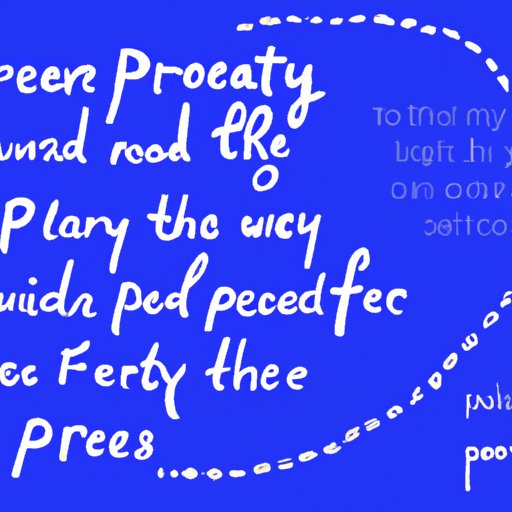
Introduction
Have you ever heard of free verse poetry? If you’re a fan of poetry, you’ve probably come across this unique form of self-expression. In contrast to traditional poetry, free verse doesn’t abide by rigid structural rules, rhyming schemes, or meters. Instead, it’s characterized by its freedom of form, where poets are free to write without constraints and use poetic devices like imagery, metaphors, and symbolism to convey their thoughts and emotions. In this article, we’ll explore what free verse poetry is, its evolution throughout history, and how you can use it as a tool for personal expression.

Breaking the Rules: A Comprehensive Guide to Free Verse Poetry
Free verse poetry is a genre of poetry that breaks traditional rules, structures, and techniques that have been established for centuries. In contrast to traditional poetry, free verse doesn’t follow a strict rhyme scheme, meter, or syllable count. However, free verse poetry still employs poetic devices such as metaphors, imagery, and symbolism. As a result, free verse gives the poet much more flexibility and freedom to express themselves and their emotions.
Some famous free verse poets are Walt Whitman, Emily Dickinson, Langston Hughes, and Walt Whitman. For example, Walt Whitman’s “Leaves of Grass” is a well-known free verse poem and a significant contribution to this genre. When writing free verse poetry, writers focus more on conveying their emotions than on adhering to structure and form, allowing poets to express themselves naturally and ordinary language.
How Free Verse Poetry Can Help You Express Yourself
Are you struggling to express your emotions? One of the benefits of free verse poetry is that it allows you to tap into your creativity and use it as an outlet to express yourself. Unlike some traditional poetry where writers are restricted to strict guidelines, free verse poetry allows you to convey your emotions through the use of language and poetic devices in a way that is authentic to you.
Free verse poetry is an excellent tool for expressing personal experiences and emotions. It affords writers the ability to write about topics that traditional poetry may not cover. For example, free verse poetry is a means to convey a personal experience that would be difficult to define in a traditional poetic form. Many writers of free verse poetry have used this style to tackle tough subjects, such as abuse or mental health.
The History and Evolution of Free Verse Poetry
The origins of free verse poetry are difficult to pinpoint. However, it was a significant aspect of the literary movement of the 20th century, which strived to break down traditional poetic forms that were seen as confining and outdated. Free verse poetry’s most significant contribution was its ability to break down the barriers between the writer and the reader, allowing poets to connect with their audiences on a more personal level.
During the 20th century, free verse continued to be an essential aspect of poetry, and many poets explored it as a form of self-expression. With this exploration, free verse has evolved, and poets take an experimental approach to find ways to make their poetry more compelling to their audience.
Tips and Techniques for Writing Free Verse Poetry
If you’re new to free verse poetry, getting started can be daunting. However, a few tips and techniques can make the process smoother. Start by reading other free verse poetry. By doing so, you’ll see how structure, line breaks, and other elements are used.
One effective technique in free verse poetry is to use imagery. Imagery will help you describe a moment by painting a picture in your readers’ minds. Remember to also use line breaks to create emphasis, and to structure your poem in a way that makes sense to you.
Comparing and Contrasting Free Verse with Other Poetic Forms
Free verse poetry is unique in contrast to other forms of poetry like haikus or sonnets. Unlike traditional poetry, it lacks definite structure or pattern. Nonetheless, all poetry forms share similarities based on certain poetic devices like imagery, metaphors, and symbolism. Since free verse’s rules are more amorphous, it can be challenging for readers to make sense of it upon first reading. These differences, though, can create beauty in how free verse allows a writer to have much more flexibility to tell stories.
Breaking Down Free Verse: Understanding the Elements and Structure of Free Verse Poetry
To write free verse poetry, it’s essential to understand the structure and elements that you can use. Line breaks are one structural element that you can use in free verse to create emphasis. Consider how long or short each line is and where you break each line. Poets also use repetition and variation of phrases to create rhythm and harmony.
It’s crucial to understand that there are no formal rules to writing free verse. Whatever you decide to structure into your poem is up to you. You can vary the line length, rhythm, or even use punctuation as a tool to create emphasis on particular words or phrases.
Conclusion
In conclusion, free verse poetry is an essential genre in the literary world. It provides writers with the freedom of expression that other poetry forms don’t. Through its origins in the 20th century and its current popularity, free verse poetry continues to grow and evolve. It’s a unique tool for personal expression and storytelling, and its flexibility has allowed poets to write about subjects traditional poetry can’t.




